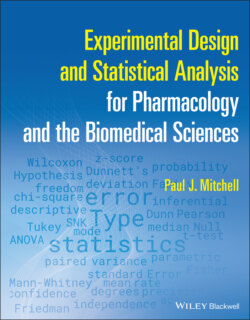Читать книгу Experimental Design and Statistical Analysis for Pharmacology and the Biomedical Sciences - Paul J. Mitchell - Страница 28
Example 3.4
ОглавлениеThere is a further situation using a similar experimental scenario which we need to consider. Here your laboratory has just purchased two new pH metres, and you wish to compare their accuracy and precision. You prepare two solutions of 0.1 mM HCl and 0.1 mM NaOH, pH values of 4.0 and 10.0, respectively, from which you carefully decant a small volume of each solution into two small beakers. You then use each pH metre, in turn, to obtain three measurements of the pH of each solution. You very carefully ensure that the pH electrode is cleaned between each measurement so as not to contaminate subsequent readings. This process and resulting pH readings are summarised in Figure 3.4.
Figure 3.4 Comparison of the accuracy and precision of two pH metres.
There is an argument here that these two sets of samples simply reflect a single measurement in triplicate, similar to that described in the first example above (see Figure 3.2). However, this situation is slightly different since here we are interested in the performance of the two pH metres. Consequently, it is perfectly reasonable to treat these measurements as independent and so n = 3 in for both pH metre for each solution, whereupon the average pH (with the spread of data described by the standard deviation) for each set of data may be calculated. This may appear inconsistent with the earlier example, but to understand why this is permissible, then you need to understand the questions being asked in both situations. In the first, we were interested in the effect of the drug or serum on the population growth of the cells and not our consistency in measuring the number of cells. In this latter situation, however, it is the relative performance of the equipment being used, in terms of accuracy, consistency, precision, and variability, that is being investigated.
The take‐home message here is that as with everything in data analysis, the question being asked is of paramount importance and is a direct consequence of the aim of the experiment.
